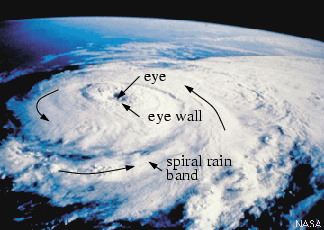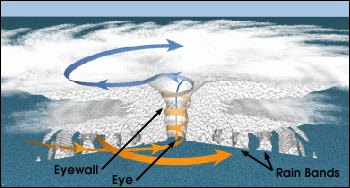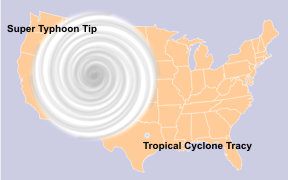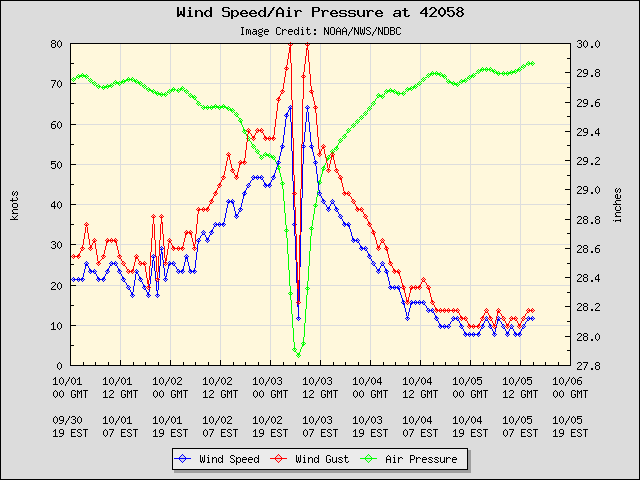In the broad belt around the earth known as the tropics -- the region within 23½° latitude north and south of the equator -- the weather is much different from the middle latitudes. The noon sun is always high in the sky and seasonal changes in temperature are small compared with the more drastic seasonal changes at higher latitudes. The daily heating of the surface and high humidity favor the development of cumulus clouds and thunderstorms. Frequent showers and non-violent thunderstorms often accompanied with heavy rainfall are typical for tropical regions. Intense and well organized storm systems are relatively rare.
Surface winds in the tropics generally blow from the east -- specifically from the northeast (in the northern hemisphere), and from the southeast (in the southern hemisphere) -- these reliable and steady winds are called the trade winds. Between these two winds flows is a belt of low pressure and surface convergence known as the intratropical convergence zone (ITCZ) (See Figure I). The ITCZ is centered over the Equator, but does move with the seasons in response to the movement of the movement of the location of most intense heating from the Sun. You may also wish to look over the Wikipedia page on the Intratropical Convergence Zone. The corresponding pattern of surface pressure is to have a line of lower pressure along the intratropical convergence zone and lines of higher pressure to the north and south of the ITCZ. Based on the simple 30° rule for determining the surface wind direction as described on the previous reading page, the surface wind will be about 30° North of East in the Northern Hemisphere. In the Southern Hemisphere the rotation of the Earth is in the opposite direction, so winds are curved to the left of the pressure gradient, so the winds south of the ITCZ are from 30° South of East.
This band of surface convergence, forced rising air, and clouds is easily seen on satellite imagery and is a prominent part of the climate of Earth. Let's take some time to look over a few satellite composite images and movies of the Earth to identify some of the major features of weather patterns around the globe. A composite image of the globe is done by stitching together (or compositing) simultaneous views from several satellites, since any one of them can only view a small portion of the Earth. The University of Wisconsin provides a Global Montage Movie that shows images created every three hours for the last 3 days.
Notice the semi-continuous band of clouds that extends across the globe near the Equator. This is the Intratropical Convergence Zone. Also notice that cloud systems at low latitudes (close to the Equator) generally move from east toward west. There may even be some active tropical storms in the three day long loop depending on when you look. Tropical storms and hurricanes will be compact swirling cloud systems most often located over low latitude regions. The movement of tropical storms is further described within upcoming reading pages.
Now look at the motion of cloud systems at higher latitudes in both the northern and southern hemisphere. These cloud systems generally move from west to east and commonly rotate or swirl. At higher latitudes the steering level winds (around 500 mb) are generally west toward east, while in the tropics these winds are generally east toward west. We have previously mentioned that the general movement of higher latitude storm systems is typically from west to east, i.e., in the direction of the 500 mb steering level winds. The large storms at higher latitudes swirl counterclockwise in the Northern Hemisphere and clockwise in the Southern Hemisphere.
Here is a link to another page of the Latest Global Composite Imagery from Plymouth State University. There are 5 different satellite products that each show a three day movie loop over the entire earth. The infrared satellite images are very good at distinguishing cloud features. This material is not highly emphasized on homework or exam questions. I thought it would be interesting to view these images to see the ITCZ and the general movement of cloud and storm systems as described above.
Occasionally, a large undulation or ripple in the normal trade wind pattern will develop and move
slowly from east toward west. These disturbances in the flow are called
tropical waves, or easterly waves. Because variaions of surface air pressure in the
tropics are so slight compared with the middle latitudes, tropical waves are best shown by plotting
steamlines of the wind patterns (rather than isobars) as shown in this
example
wind pattern near tropical waves.
The example also indicates where areas of surface convergence (which forces rising motion resulting in the
development of clouds and rain) and surface divergence (which forces sinking motion resulting in mainly clear
skies) occur relative to the position of the easterly wave. Click on the "Overlay" button above the image
to see the corresponding satellite image of cloud cover.
The typical westward movement of a tropical easterly wave is
shown in this animation of a tropical wave moving across the Caribbean.
Although the majority of tropical waves die out before becoming major systems,
if conditons are favorable, tropical waves can intensify, develop a central low pressure region
around which the winds rotate, and
grow into hurricanes. In fact, most severe hurricanes that affect the United States begin
as easterly waves, which move off the continent of Africa.
More information and
a diagram can be found in this African Easterly Wave Link (Click on the image to zoom).
Unfortunately, the previous link has changed. Please use the following link to view the image, labeled as
tropical wave formation,
Wikipedia page on Tropical Waves. Click on
the picture to view a
larger image for Atlantic Tropical Wave Formation.
Usually these easterly waves are relatively weak until
they move into the warmer waters in the western Atlantic, Caribbean, and Gulf of Mexico where, if other conditions are favorable,
can develop into tropical cyclones and hurricanes.
During the summer monsoon season in Arizona, remnants of tropical easterly waves sometimes move from the Gulf of Mexico westward across northern Mexico and even southern Arizona. These waves often act to enhance rainfall in Arizona.
Although a lot of the severe hurricanes that affect the United States begin as easterly waves that move off Africa and across the Atlantic, there have been many cases where hurricanes initially formed much closer to the United States -- in the Carribean and Gulf of Mexico. In those cases it often appears that a region of surface convergence or upper-level divergence with an associated area of disorganized thunderstorms eventually develops rotation and strengthens.
Tropical cyclone is the generic name given to a surface low pressure system over tropical waters, with organized convection (i.e., thunderstorm activity) and a definite cyclonic (or counter-clockwise) surface wind pattern (See Figure J). Here again is the surface weather map showing Hurricane Katrina in August 2005. Recall from the previous reading pages that the ground surface winds around a circular area of lower pressure (in the Northern Hemisphere) are counterclockwise, but also inward. The speed of the wind depends on how rapidly air pressure increases in moving out from the low pressure center. As described in Figure J, the speed of the wind and strength of the storm depends on how low the central pressure gets. Remember that the average sea level pressure is about 1000 mb (1013.25 mb to be exact), and somewhere outside the storm, the pressure will have to return to average, thus the lower the central pressure of the storm, the stronger the pressure gradient, the stronger the winds and the stronger the storm. Tropical storms and hurricanes also form in the southern hemisphere. Because the Coriolis force acts in the opposite direction, the wind field around a tropical cyclone (or any circular low pressure pressure system) in the Southern Hemisphere is clockwise and converging (inward). As a tropical cyclone intensifies, it is classified according to wind speed.
(*)Hurricane is the term used in the north Atlantic Ocean and the north and south Pacific oceans east of the dateline. These storms are given different names in other ocean basins:
Tropical storms and hurricanes are the only natural disasters which have their own names (e.g., Andrew, Camille, Hugo, the 2004 Florida hurricanes, Charles, Frances, Ivan, and Jeanne, the damaging 2005 hurricanes, Dennis, Katrina, Rita, and Wilma, strong 2008 hurricanes, Gustov and Ike, and the damaging 2017 hurricanes, Harvey, Irma, and Maria). Names seem appropriate because we commonly come to know hurricanes long before they strike land, often watching these storms move across the oceans for days or even weeks. By contrast isolated severe thunderstorms and tornadoes develop suddenly and last only hours. Hurricanes are much larger than an individual severe thunderstorm cell and are more correctly described as being composed of an organized clustering of thunderstorms. They are quite powerful and release great amounts of energy (mostly in the form of latent heat released by the condensation of water in cloud formation). In fact the energy released by a single, strong hurricane can be greater than the total annual energy consumption of the United States and Canada combined.
The hurricane season in the North Atlantic Ocean officially runs from June 1 through November 30, although tropical storms in the North Atlantic sometimes develop outside of this period. Each year a new list of names is used for the storms that reach tropical storm strength. The first storm is given a name that begins with 'A', the second begins with 'B', and so forth. Not all letters are used. Each year a list of 21 names is used to name the storms in the order that they form (List of Tropical Storm names for the North Atlantic Ocean). The US started using names back in 1953. At first all storms were given female names. Beginning in 1979, traditionally male and female names have been alternated.
Surface atmospheric pressure in the center of a hurricane tends to be extremely low. The lowest pressure reading ever recorded for a hurricane was Super Typhoon Tip in 1979, which had a central pressure of 870 millibars (mb). The average sea level pressure at the center of storms that reach hurricane strength is near 960 mb. Wind speed in a hurricane is highly related to the surface pressure of the storm, since the windspeed is determined by the pressure gradient or the change in air pressure divided by the distance over which the pressure change happens. The average sea level air pressure on Earth is 1013.25 mb. The the pressure gradient (and hence windspeed) depends on the difference in pressure between the lowest pressure in the center of the storm and the pressure outside the storm (average 1013 mb) divided by the distance over which the pressure change happens. In general, the lower the central pressure, the higher the windspeeds generated. In fact hurricanes are classified by either windspeed or the central pressure (with lower pressure being more intense). See this link to Saffir-Simpson Hurricane Classification Table to see the criteria for Category 1 through Category 5 Hurricanes, which can be defined by either central pressure or windspeed. Hurricanes that reach category 3, 4, or 5 strength are called major hurricanes. The graph below shows the relationship between surface pressure and sustained wind speed for a number of tropical low pressure systems. This is a rather old figure and does not contain data from hurricanes after 1990.
| Relationship between surface pressure and wind speed for a number of tropical low pressure systems. Tropical low pressure systems are classified as hurricanes when their pressure is 980 millibars or lower, and sustained wind speeds are greater than 118 kilometers per hour. |
For historical perspective, the table below shows the seven strongest hurricanes ever observed in the Atlantic Ocean for which reliable measurements are available based on the central pressure. The left side is for observations over the open ocean, while the right side is for pressure measured at the time of hurricane landfall.
| Top seven most intense Atlantic hurricanes since measurements began Hurricane intensity is measured solely by central pressure, source:Wikipedia |
|||||||
|---|---|---|---|---|---|---|---|
| North Atlantic | Landfall U.S. | ||||||
| Rank | Hurricane | Year | Pressure | Rank | Hurricane | Year | Pressure |
| 1 | Wilma | 2005 | 882 mbar | 1 | "Labor Day" | 1935 | 892 mbar |
| 2 | Gilbert | 1988 | 888 mbar | 2 | Gilbert | 1988 | 900 mbar |
| 3 | "Labor Day" | 1935 | 892 mbar | 3 | Camille | 1969 | 900 mbar |
| 4 | Rita | 2005 | 895 mbar | 4 | Dean | 2017 | 905 mbar |
| 5 | Allen | 1980 | 899 mbar | 5 | "Cuba" | 1924 | 910 mbar |
| 6 | Camille | 1969 | 900 mbar | 6 | Dorian | 2019 | 910 mbar |
| 7 | Katrina | 2005 | 902 mbar | 7 | Janet | 1955 | 914 mbar |
A hurricane is an intense storm of tropical origin, with sustained winds exceeding 64 knots (74 mi/hr). Below is a photo of Hurricane Elena. The storm is approximately 500 km (310 mi) in diameter, which is about average for hurricanes. The area of clear skies (with perhaps scattered clouds) in the center is the eye of the storm. Elena's eye is almost 40 km (25 mi) wide. Within the eye, winds are light and skies are mostly clear of clouds. The surface pressure is very low, nearly 955 mb.
 |
| Hurricane Elena as photographed from the space shuttle Discovery during September, 1985. |
 |
| Structure of a Hurricane |
 |
| Comparing the size of the very large Typhoon Tip to the very small Typhoon Tracy overlaid on the continental US for scale. The size of the storm is the extent of tropical force winds. |
Notice that the clouds align themselves into spiraling bands (called spiral rain bands) that swirl in toward the storm's center, where they wrap themselves around the eye. Surface winds increase in speed as they blow counterclockwise and inward toward this center.
Adjacent to the eye is the eye wall, a ring of intense thunderstorms that whirl around the storm's center and extend upward to almost 15 km (49,000 ft) above sea level. Notice that the cloud tops in the eye wall region extend above the other clouds. Within the eye wall we find the heaviest precipitation and the strongest winds. Please take a look at Figure K which shows a top-down view of a typical hurricane. While Figure K provides numbers for the average size of a tropical storm, you should realize that storm size can vary quite alot.
The size of a tropical system can be defined as the area over which tropical force winds or stronger are observed. Obviously, the larger the storm, the greater potential damage it may cause. Both the maximum wind strength and the size of the wind field are important. Super Typhoon Tip is the largest storm ever recorded, with tropical force winds 2100 km (1300 miles) in diameter around the center of the storm. Compare that to a much smaller, yet powerful Tropical Cyclone Tracy, a category 4 storm that devasted parts of northern Australia in 1974. Indian Ocean storms are called tropical cyclones, rather than hurricanes or typhoons.
As the center of a hurricane approaches, the air pressure falls. The lowest air pressure happens when the eye or center of the storm passes over. Air pressure then increases as the center moves away. This is shown in the figure below, which shows measurements from an auotmated buoy over the ocean as Hurricane Matthew passed over in 2016. The green line, with its scale on the right, shows the measured air pressure. The diagram covers five days as shown along the horizontal axis. Note the rapid change in air pressure just before and after the eye passes over. This indicates the rapid change in air pressure, i.e., strong pressure gradient, near the storm. The corresponding sustained wind speed and wind gust speed are shown in blue and red, with its scale on the left. The highest wind speeds and strongest pressure gradient, indicated by the rapid change in air pressure with time, happens when the eyewall passes overhead. Notice the relatively calm winds when the eye passes over. One side of the eyewall passes over before the eye, followed by the eyewall on the other side of the storm.
 |
| Wind and Pressure measured by an automated buoy as the eye of Hurricane Matthew passes over in 2016. |
All strong tropical cyclones consist of the following components:
You should be familar with the basic anatomy of a hurricane, as most hurricanes have the features mentioned above. It is beyond the scope of this course to explain and understand why these storms organize themselves in this manner. For example, you should know that the eye is an area of calm winds and low surface pressure with sinking air and generally fair skies, but the reason for this has not been explained.